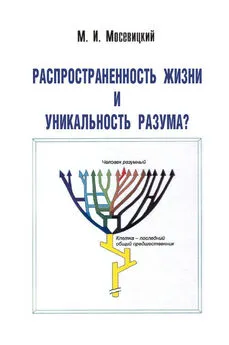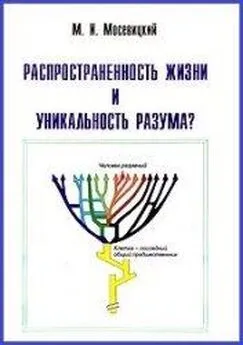Марк Мосевицкий - Распространненость жизни и уникальность разума?
- Название:Распространненость жизни и уникальность разума?
- Автор:
- Жанр:
- Издательство:ПИЯФ РАН
- Год:2008
- Город:Санкт-Петербург
- ISBN:5-86763-203-2
- Рейтинг:
- Избранное:Добавить в избранное
-
Отзывы:
-
Ваша оценка:
Марк Мосевицкий - Распространненость жизни и уникальность разума? краткое содержание
Исследование самых ранних осадочных пород показывает, что клеточные формы жизни присутствовали на Земле около 3.85 млрд лет тому назад, т. е. появились вскоре после создания совместимых с жизнью условий. Это означает, что доклеточная эволюция при всей ее сложности могла быть осуществлена в очень короткий срок (10–50 млн лет). Согласно другой версии, доклеточная эволюция происходила вне Земли (панспермия). В любом случае пример Земли позволяет предполагать широкое распространение жизни везде, где созданы подходящие для ее развития условия. С другой стороны, палеонтологическая летопись, начатая около 3.5 млрд лет тому назад, позволила выявить многочисленные кризисы (вымирания), приводившие к крутым разворотам в ходе эволюционного процесса. В основе эволюционных кризисов лежали природные катастрофы, вызванные падениями астероидов, глобальными оледенениями, длительными (в течение миллионов лет) истечениями лавы, изменениями газового баланса в океане и атмосфере. Бесчисленные воздействия на эволюцию оказывали также происходившие спонтанно мутации и горизонтальные обмены генетическим материалом. Благодаря наложению большого числа случайных факторов эволюционный процесс каждый раз является уникальным. На Земле после почти 4-х млрд лет существования жизни эволюционный процесс дал единственную ведущую к разуму ветвь гоминин (прямоходящих наследников шимпанзе). После многих критических ситуаций на этой ветви сохранился один побег – современное человечество. Отсутствие признаков существования других цивилизаций в доступном для общения космосе подтверждает весьма низкую вероятность выхода эволюции на маршрут, ведущий к разуму. Понимание природы кризисных событий, имевших место на Земле в прошлом, необходимо для того, чтобы, опираясь на все возрастающие возможности человечества, предотвратить наступление этих событий в будущем или хотя бы смягчить их последствия. Основной материал доступен широкому кругу читателей. Автор стремился также сделать книгу интересной для специалистов. Этим, в частности, объясняется большое число ссылок на последние публикации в научных журналах.
Распространненость жизни и уникальность разума? - читать онлайн бесплатно ознакомительный отрывок
Интервал:
Закладка:
Nisbet E. G. and Fowler (1996) Some liked it hot. Nature, 382, 404―405.
Nissen P. et al. (2000) The structural basis of ribosome activity in peptide bond synthesis. Science, 289, 920―930.
Nuevo M. et al. (2008) A Detailed Study of the Amino Acids Produced from the Vacuum UV Irradiation of Interstellar Ice Analogs. Orig. Life. Evol. Biosph., 38, 37―56.
Noonan J. P. et al. (2006) Sequencing and analysis of Neanderthal genomic DNA. Science, 314, 1113―1118.
Oberbeck V. R. et al. (1991) Prebiotic chemistry in clouds. J. Mol. Evol., 32, 296―303.
Ohmoto H. et al. (1993) 3.4-billion-year-old biogenic pyrites from Barberton, South Africa: sulfur isotope evidence. Science, 262, 555―557.
Ohta T. (1987). Very slightly deleterious mutations and the molecular clock. J. Mol. Evol., 26, 1―6.
Olivieri A. et al. (2007) The mtDNA legacy of the Levantine early Upper Palaeolithic in Africa. Science, 314, 1767―1770.
Olsen G. J. and W―se C. R. (1997) Arcaeal genomics: an overview. Cell, 89, 991―994.
Olsen P. E. (2002) Ascent of dinosaurs linked to an iridium anomaly at the Triassic-Jurassic boundary. Science, 296, 1305―1307.
Olson M. (1999) When less is more: Gene loss as an engine of evolutionary change. Am. J. Hum. Genet., 64, 18―23.
Oro J. (1961) Mechanizm of synthesis of adenine from hydrogen cyanide under possible primitive earth conditions. Nature, 191, 1193―1194.
Oro J. and Guidry C. L. (1961) Direct synthesis of polypeptides. I. Polycondensation of glycine in aqueous ammonia. Arch. Biochem. Biophys., 93, 166―171.
Oro J. and Kamat S. S. (1961) Amino acid synthesis from hydrogen cyanide under possible primitive earth conditions. Nature, 190, 442―443.
Oro J. and Kimball A. P. (1961) Synthesis of purines under possible primitive earth conditions. I. Adenine from hydrogen cyanide. Arch. Biochem. Biophys., 94, 217―227.
Oro J. et al. (1990) The origin and early evolution of life on Earth. Annu. Rev. Earth.
Planet Sci., 18, 317―356.
Ouzounis C. A. et al. (2006) A minimal estimate for the gene content of the last universal common ancestor-exobiology from a terrestrial perspective. Res. Microbiol., 157, 57―68.
Ovchinnikov I. V. et al. (2000) Molecular analysis of Neanderthal DNA from the northern Caucasus. Nature, 404, 490―493.
Pace N. R. (1991) Origin of life ― facing up to the physical setting. Cell, 65, 531―533.
Pakendorf B. and Stoneking M. (2005) Mitochondrial DNA and human evolution. Annu. Rev. Genomics Hum. Genet., 6, 165―183.
Palanichamy M. G. et al. (2004) Phylogeny of mitochondrial DNA macrohaplogroup N in India, based on complete sequencing: implications for the peopling of South Asia. Am. J. Hum. Genet., 75, 966―978.
Paris F. et al. (2000) The effects of the final stages of the Late Ordovician glaciation on marine palynomorphs (chitinozoans, acritarchs, leiospheres) in well Nl-2 (NE Algerian Sahara). Rev. Palaeobot. Palynol., 113, 87―104.
Passarino G. et al. (1998) Different genetic components in the Ethiopian population, identified by mtDNA and Y-chromosome polymorphisms. Am. J. Hum. Genet., 62, 420―34.
Paul N. and Joyce G. F. (2004) Minimal self-replicating systems. Curr. Opin. Chem. Biol., 8, 634―639.
Pavlov A. A. et al. (2000) Greenhouse warming by CH4 in the atmosphere of early Earth. J. Geophys. Res., 105, 11981―11990.
Pavlov P. et al. (2001) Human presence in the European Arctic nearly 40,000 years ago. Nature, 413, 64―67.
Payton A. et al. (2003) Cathepsin D exon 2 polymorphism associated with general intelligence in a healthy older population. Mol. Psych., 8, 14―18.
Penny D. (1988) What was the first living cell? Nature, 331, 111―112.
Penny D. (1995) Improved analyses of human mtDNA sequences support a recent African origin for Homo sapiens. Mol. Biol. Evol., 12, 863―82.
Perry C. A. and Hsu K. J. (2000) Geophysical, archaeological, and historical evidence support a solar-output model for climate change, Proc. Natl. Acad. Sci. USA, 97, 12433― 12438.
Pflug H. D. (1984) Early geological record and the origin of life. Naturwissenschaften, 71, 63―68.
Pienta K. J. and Coffey D. S. (1984) A structural analysis of the role of the nuclear matrix and DNA loops in the organization of the nucleus and chromosome. J. Cell. Sci. Suppl., 1, 123―135.
Pierazzo E. et al. (2003) Chicxulub and climate: radiative perturbations of impact-produced S-bearing gases. Astrobiology, 3, 99―118.
Pierrehumbert R. T. (2004) High levels of atmospheric carbon dioxide necessary for the termination of global glaciation. Nature, 429, 646―6649.
Pitulko V. V. et al. (2004) The Yana RHS site: humans in the Arctic before the last glacial maximum. Science, 303, 52―56.
Pizzarello S. (2004) Chemical evolution and meteorites: an update. Orig. Life Evol., Biosph., 34, 25―34.
Pizzarello S. and Cronin J. R. (2004) Non-racemic amino acids in the Murray and Murchison meteorites. Geochim. Cosmochim. Acta, 64, 329―338.
Plagnol V. and Wall J. D. (2006) Possible ancestral structure in human populations. PLoS Genet., 2, e105.
Polak P. and Domany E. (2006) Alu elements contain many binding sites for transcription factors and may play a role in regulation of developmental processes. BMC Genomics,7, 133 (15 pages).
Pollard K. S. et al. (2006 a) An RNA gene expressed during cortical development evolved rapidly in humans. Nature, 443, 167―172.
Pollard K. S. et al. (2006b) Forces shaping the fastest evolving regions in the human genome. PLoS Genet., 2, 1599―1611.
Ponce de Leon M. S. and Zollikofer C. P. (2001) Neanderthal cranial ontogeny and its implications for late hominid diversity. Nature, 412, 534―538.
Ponjavic J. et al. (2007) Functionality or transcriptional noise? Evidence for selection within long noncoding RNAs. Genome Res., 17, 556―565.
Ponting C. P. and Lunter G. (2006) Signatures of adaptive evolution within human non-coding sequence. Hum. Mol. Genet., 15, Spec № 2, R170―175.
Poole A. et al. (1999) Early evolution: prokaryotes, the new kids on the block. Bi―ssais, 21, 880―889.
Poole A. M. and Logan D. T. (2005) Modern mRNA proofreading and repair: clues that the last universal common ancestor possessed an RNA genome? Mol. Biol. Evol., 22, 1444―1455.
Pope K. O. et al. (1994) Impact winter and the Cretaceous/Tertiary extinctions: results of a Chicxulub asteroid impact model. Earth Planet Sci. Lett., 128, 719―725.
Pope K. O. et al. (1997a) Surface expression of the Chicxulub crater. Geology, 25, 567―598.
Pope K. O. et al. (1997b) Energy, volatile production, and climatic effects of the Chicxulub Cretaneous/Tertiary impact. J. Geophys. Res., 102, 21645―21664.
Poreda R. J. and Becker L. (2003) Fullerenes and interplanetary dust at the Permian-Triassic boundary. Astrobiology, 3, 75―90.
Price D. L. et al. (1998) Alzheimer disease ― when and why? Nature Gen., 19, 314―316.
Pu L. et al. (1977) Preliminary study on the age of Yuanmou man by palaeomagnetic technique. Sci. Sin., 20, 645―664.
Quintana-Murci L. et al. (1999) Genetic evidence of an early exit of Homo sapiens sapiens from Africa through eastern Africa. Nat. Genet., 23, 437―441.
Rabinowitz D. et al. (2000) A reduced estimate of the number of kilometre-sized near-Earth asteroids. Nature, 403, 165―166.
Ramakrishnan U. et al. (2005) Detecting past population bottlenecks using temporal genetic data. Mol. Ecol., 14, 2915―2922.
Rasmussen B. (2000) Filamentous microfossils in a 3,235-million-year-old volcanogenic massive sulphide deposit. Nature, 405, 676―679.
Rasmussen S. et al. (2003) Bridging nonliving and living matter. Artif. Life, 9, 269―316.
Rasmussen S. et al. (2004) Transitions from nonliving to living matter. Science, 303, 963―965.
Raulin F. and Greenberg J. M. (1997) From the interstellar clouds, through the inner to the outer solar system: a universally distributed complex organic chemistry. Preface. Adv. Space Res., 19, 975―978.
Ravizza G. et al. (2003) Chemostratigraphic evidence of Deccan volcanism from the marine osmium isotope record. Science, 302, 1392―1395.
Ray N. et al. (2005) Recovering the geographic origin of early modern humans by realistic and spatially explicit stimulation. Genome Res. 15, 1161―1167.
Razin S. V. et al. (1985) Low ionic strength extraction of nuclease-treated nuclei destroys the attachment of transcriptionally active DNA to the nuclear skeleton. Nucl. Acids Res., 13, 7427―7444.
Reichow M. K. et al. (2002) 40Ar/39Ar dates from the West Siberian Basin: Siberian flood basalt province doubled. Science, 296, 1846―1849.
Reiss A. L. et al. (1995) Contribution of the FMR1 gene mutation to human intellectual disfunction. Nat. Genet., 11, 331―334.
Relethford J. H. (2001) Ancient DNA and the origin of modern humans. Proc. Natl. Acad. Sci. USA, 98, 390―391.
Rettberg P. et al. (2002) Survival of microorganisms in space protected by meteorite material: results of the experiment fiEXOBIOLOGIEfl of the PERSEUS mission. Adv. Space Res. 30, 1539―1545.
Ribeiro S. and Golding G. B. (1998) The mosaic nature of the eukaryotic nucleus. Mol. Biol. Evol., 15, 779―788.
Richards M. (2004) Perfecting people: selective breeding at the Oneida Community and eugenics movement. New Genet. Soc., 23, 47―71.
Rightmire G. P. (1998) Evidence from facial morphology for similarity of Asian and African representatives of Homo erectus. Am. J. Phys. Antropol., 106, 61―85.
Rightmire G. P. et al. (2006) Anatomical descriptions, comparative studies and evolutionary significance of the hominin skulls from Dmanisi, Republic of Georgia.
J. Hum. Evol., 50, 115―141.
Rivera M. C. and Lake J. A. (2004). The ring of life provides evidence for a genome fusion origin of eukariotes. Nature, 431, 152―155.
Rosa L. P. and Faber J. (2004) Quantum models of the mind: are they compatible with environment decoherence? Phys. Rev. E Stat. Nonlin. Soft Matter Phys., 70, 031902.
Rossignol-Strick M. and Barghoorn E. S. (1971) Extraterrestrial abiogenic organization of organic matter: the hollow spheres of the Orgueil meteorite. Space Life Sci., 3, 89―107.
Rossini P. M. and Rossi S. (2007) Transcranial magnetic stimulation: diagnostic, therapevtic, and research potential. Neurology, 68, 484―488.
Routtenberg A. (2000) Enhanced learning after geneticoverexpressionof a brain growth protein. Proc. Natl. Acad. Sci. USA, 97, 7657―7662.
Rowold D. J. et al. (2007) Mitochondrial DNA geneflow indicates preferred usage of the Levant Corridor over the Horn of Africa passageway. J. Hum. Genet., 52, 436―447.
Rujescu et al. (2003) M129V variation in the prion protein may influence cognitive performance. Mol. Psychiatry, 8, 937―941.
Rushton J. P. et al. (2007) No evidence that polymorphisms of brain regulator genes Microcephalin and ASPM are associated with general mental ability, head circumference or altruism. Biol. Lett., 3, 157―160.
Sabeti P. C. et al. (2007) Genome-wide detection and characterization of positive selection in human populations. Nature, 449, 913―918.
Sagan C. et al. (1993) A search for life on Earth from the Galileo spacecraft. Nature, 365, 715―721.
Saghatelian A. et al. (2001) A chiroselective peptide replicator. Nature, 409, 797―801.
Satta Y. and Takahata N. (2002) Out of Africa with regional interbreeding? Modern human origins. Bi―ssays, 24, 871―875.
Savulescu J. (2001) Procreative beneficience: why we should select the best children. Bi―thics, 15, 413―426.
Saxena S. (2003) Small RNAs with imperfect match to endogenous mRNA repress translation. Implications for off-target activity of small inhibitory RNA in mammalian cells. J. Biol. Chem., 278, 44312―44319.
Читать дальшеИнтервал:
Закладка:








